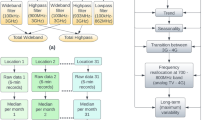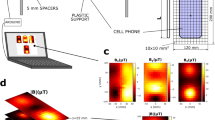Abstract
The assessment of magnetic field exposure in children is an important point in the context of epidemiological issues. EXPERS is the first study ever carried out measuring personal exposure to extremely low frequency magnetic fields at a national scale, involving 977 French children with 24 h personal measurements. Descriptive statistical analyses were performed for all the children, and only for children where no alarm clock was identified, as in some cases this requirement of the measurement protocol was not respected. The proportion of children with a 24 h arithmetic mean of ≥0.4 μT was 3.1% when considering all children and 0.8% when excluding alarm clocks. The alarm clocks were the main variable linked to the child exposure measurements. Magnetic field exposure increased when the home was located close to a high voltage power line. However, none of the 0.8% of children living at <125 m to a 225 kV line or <200 m to a 400 kV overhead line had a personal exposure of >0.4 μT. A multiple correspondence analysis showed the difficulty to build a statistical model predicting child exposure. The distribution of child personal exposure was significantly different from the distribution of exposure during sleep, questioning the exposure assessment in some epidemiological studies.
This is a preview of subscription content, access via your institution
Access options
Subscribe to this journal
Receive 6 print issues and online access
$259.00 per year
only $43.17 per issue
Buy this article
- Purchase on Springer Link
- Instant access to full article PDF
Prices may be subject to local taxes which are calculated during checkout








Similar content being viewed by others
References
Wertheimer N, Leeper E . Electrical wiring configurations and childhood cancer. Am J Epidemiol 1979; 109: 273–284.
World Health Organization. Extremely low frequency fields. WHO: Geneva, Switzerland, 2007; p 519.
Scientific Committee on Emerging Newly Identified Health Risks. Opinion on potential health effects of exposure to electromagnetic fields. Bioelectromagnetics 2015; 36: 480–484.
Decat G, Van Den Heuvel I, Mulpas L . Final report of the BBEMG research contract (July 2001-June 2005) - Monitoring survey of the 50 Hz magentic field for the estimation of the proportion of Belgian children exposed to the epidemiological cut-off points of 0.2, 0.3 and 0.4 microtesla. VITO: Mol, Belgium, 2005.
McBride ML, Gallagher RP, Theriault G, Armstrong BG, Tamaro S, Spinelli JJ et al. Power-frequency electric and magnetic fields and risk of childhood leukemia in Canada. Am J Epidemiol 1999; 149: 831–842.
Green LM, Miller AB, Agnew DA, Greenberg ML, Li J, Villeneuve PJ et al. Childhood leukemia and personal monitoring of residential exposures to electric and magnetic fields in Ontario, Canada. Cancer Causes Control 1999; 10: 233–243.
Investigators UCCS. Exposure to power-frequency magnetic fields and the risk of childhood cancer. UK Childhood Cancer Study Investigators. Lancet 1999; 354: 1925–1931.
Schuz J, Grigat JP, Stormer B, Rippin G, Brinkmann K, Michaelis J . Extremely low frequency magnetic fields in residences in Germany. Distribution of measurements, comparison of two methods for assessing exposure, and predictors for the occurrence of magnetic fields above background level. Radiat Environ Biophys 2000; 39: 233–240.
Schuz J, Grigat JP, Brinkmann K, Michaelis J . Residential magnetic fields as a risk factor for childhood acute leukaemia: results from a German population-based case-control study. Int J Cancer 2001; 91: 728–735.
Karipidis KK . Survey of residential power-frequency magnetic fields in Melbourne, Australia. Radiat Prot Dosimetry 2015; 163: 81–91.
Kabuto M, Nitta H, Yamamoto S, Yamaguchi N, Akiba S, Honda Y et al. Childhood leukemia and magnetic fields in Japan: a case-control study of childhood leukemia and residential power-frequency magnetic fields in Japan. Int J Cancer 2006; 119: 643–650.
Linet MS, Hatch EE, Kleinerman RA, Robison LL, Kaune WT, Friedman DR et al. Residential exposure to magnetic fields and acute lymphoblastic leukemia in children. N Engl J Med 1997; 337: 1–7.
Clinard F, Milan C, Harb M, Carli PM, Bonithon-Kopp C, Moutet JP et al. Residential magnetic field measurements in France: comparison of indoor and outdoor measurements. Bioelectromagnetics 1999; 20: 319–326.
Bedja M, Magne I, Souques M, Lambrozo J, Le Brusquet L, Fleury G et al. Methodology of a study on the French population exposure to 50 Hz magnetic fields. Radiat Prot Dosimetry 2010; 142: 146–152.
Sermage-Faure C, Demoury C, Rudant J, Goujon-Bellec S, Guyot-Goubin A, Deschamps F et al. Childhood leukaemia close to high-voltage power lines—the Geocap study, 2002-2007. Br J Cancer 2013; 108: 1899–1906.
Clinard F, Deschamps F, Milan C, Bouvier AM, Carli PM, Moutet JP et al. Évaluation de l’exposition aux champs magnétiques dans les habitations situées à proximité des lignes de transport de l’électricité en France. Environ Risque Sante 2004; 3: 111–118.
Friedman DR, Hatch EE, Tarone R, Kaune WT, Kleinerman RA, Wacholder S et al. Childhood exposure to magnetic fields: residential area measurements compared to personal dosimetry. Epidemiology 1996; 7: 151–155.
Acknowledgements
This study was funded by the Ministry of Health and Solidarities and realized by SUPELEC, EDF and RTE. We thank ERDF and RTE for making the electric network position data available.
Author information
Authors and Affiliations
Corresponding author
Ethics declarations
Competing interests
The authors declare no conflict of interest.
Additional information
Supplementary Information accompanies the paper on the Journal of Exposure Science and Environmental Epidemiology website
Rights and permissions
About this article
Cite this article
Magne, I., Souques, M., Bureau, I. et al. Exposure of children to extremely low frequency magnetic fields in France: Results of the EXPERS study. J Expo Sci Environ Epidemiol 27, 505–512 (2017). https://doi.org/10.1038/jes.2016.59
Received:
Accepted:
Published:
Issue Date:
DOI: https://doi.org/10.1038/jes.2016.59



